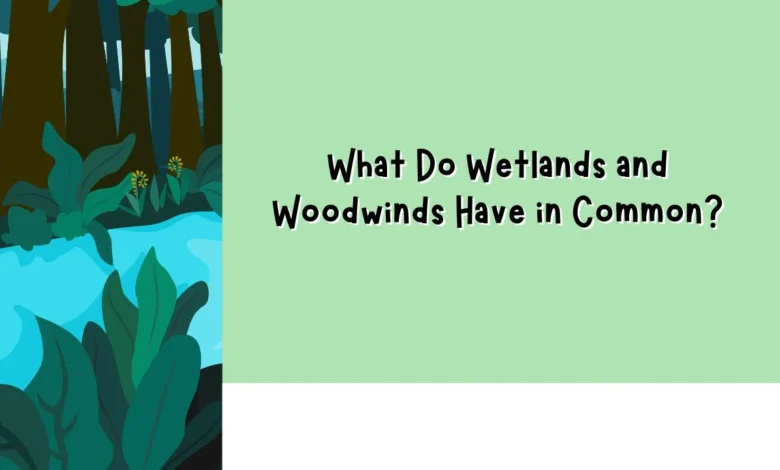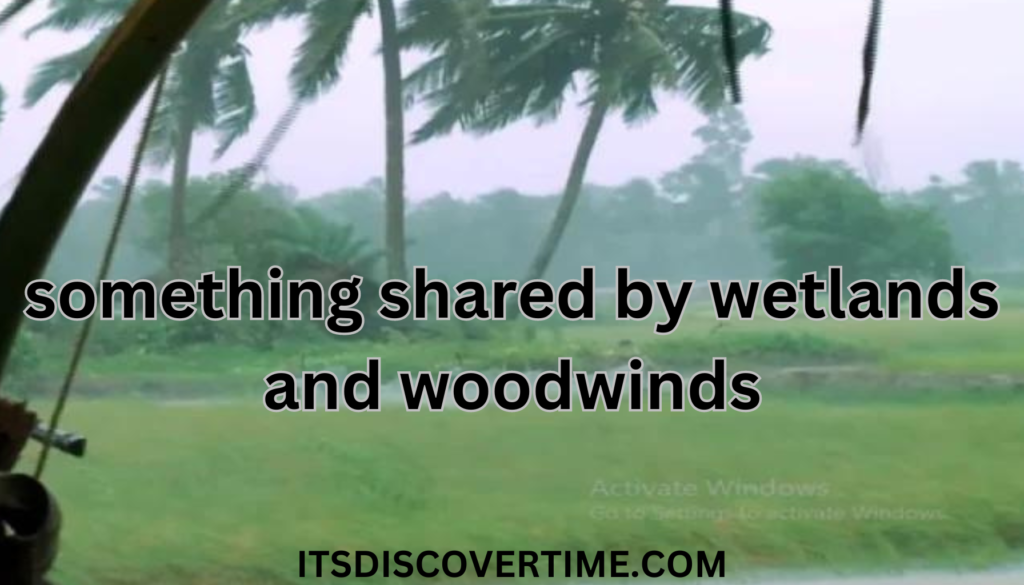Unveiling the Intricate Relationship Between Wetlands and Woodwinds: A Comprehensive Analysis
Introduction to the Connection Between Wetlands and Woodwinds
The relationship between wetlands and woodwind instruments has been a profound and personal discovery for me. As I walked through a tranquil wetland, I noticed that the natural sounds mirrored the gentle, melodious tones of my favorite woodwind instruments. This fascinating interplay between nature and music sparked a deep appreciation for both, illustrating how our surroundings subtly yet powerfully shape our artistic expressions.
The Acoustic Harmony of Wetlands and Woodwinds
Wetlands and woodwinds both excel in creating and enhancing distinct acoustic experiences. The serene soundscapes of wetlands and the resonant tones of woodwind instruments both evoke a profound sense of harmony and tranquility, deeply resonating with the human spirit.

Examining the Connection Between Wetlands and Woodwinds
Contrasting Realms: Wetlands and Woodwinds
At a cursory glance, wetlands and woodwind instruments might appear to belong to entirely separate domains. Wetlands, characterized by their water-saturated ecosystems, seem worlds apart from woodwinds, a category of musical instruments. Yet, there exists an unexpected connection linking these seemingly disparate realms. This article aims to uncover that connection, delving into the traits and insights that unify wetlands and woodwinds. We endeavor to provide a detailed exploration, offering new perspectives and thorough analysis.
Understanding Wetlands and Their Significance
Defining Wetlands and Their Varieties
Wetlands are regions where water covers or saturates the soil, either permanently or seasonally. These ecosystems include marshes, swamps, bogs, and fens, each characterized by unique features influenced by location, water chemistry, and vegetation.
Ecological Significance of Wetlands
- Water Filtration: Wetlands naturally purify water by trapping pollutants and excess nutrients before they flow into larger bodies of water.
- Flood Control: They absorb surplus rainwater, mitigating the effects of floods and reducing damage during heavy rainfall.
- Wildlife Habitat: Wetlands are vital habitats for diverse wildlife, including birds, amphibians, and fish.
- Climate Regulation: Wetlands sequester carbon dioxide, playing a crucial role in global carbon regulation and aiding in climate change mitigation.
- Erosion Prevention: The vegetation in wetlands stabilizes soil, minimizing erosion and protecting adjacent waterways.
The Diverse Biodiversity of Wetlands
Wetlands are among the most biodiverse ecosystems globally, supporting a wide range of plant and animal species. Many species have developed unique adaptations to thrive in these environments, contributing significantly to the health of global ecosystems.
Exploring Woodwind Instruments
Defining Woodwind Instruments and Their Types
Woodwinds are a category of instruments that produce sound through the vibration of air. This group includes the flute, clarinet, oboe, and bassoon, each generating distinctive tones based on their construction and sound production methods.
The Evolution of Woodwind Instruments
- Ancient Origins: Woodwind instruments trace their origins to ancient civilizations, with early examples from Egyptian, Greek, and Roman cultures.
- Medieval Developments: Instruments such as the shawm and recorder were prominent in medieval Europe, evolving from earlier designs.
- Renaissance Innovations: The Renaissance era saw significant advancements in woodwind construction, notably the development of the modern flute and oboe.
- Baroque Era Enhancements: During the Baroque period (1600-1750), composers like Bach and Handel elevated woodwind instruments, showcasing their unique tones.
- Classical and Romantic Era Innovations: The Classical and Romantic periods (1750-1900) introduced further improvements in key systems and playing techniques, enhancing woodwind versatility and range.
Cultural and Musical Importance of Woodwinds
Woodwinds occupy a special place in music and culture, with their distinct sounds used to convey a range of emotions. These instruments are integral to various musical traditions worldwide, from classical symphonies to folk music, enriching both the musical landscape and cultural expression.
Identifying Common Ground Between Wetlands and Woodwinds
Shared Acoustic Features
Both wetlands and woodwinds are associated with unique acoustic properties. Wetlands’ expansive water surfaces and plant life influence sound waves, creating distinctive acoustic environments. Similarly, woodwind instruments are designed to produce specific sound qualities, shaped by their construction and materials.
Environmental and Ecological Impacts
- Habitat Preservation: Wetlands safeguard essential wildlife habitats, while woodwind instruments often symbolize nature in cultural contexts.
- Water Quality Enhancement: Wetlands improve water quality by filtering pollutants, paralleling the clarity and purity of woodwind sounds.
- Flood Mitigation: Wetlands help manage flooding by absorbing excess water, akin to how woodwinds offer soothing melodies amidst chaotic soundscapes.
- Climate Action: Wetlands capture carbon dioxide, aiding climate regulation, similar to how woodwind music can evoke environmental awareness.
- Erosion Control: The role of wetland vegetation in preventing soil erosion mirrors the stabilizing effect of woodwind melodies in music.
Cultural Reflections and Artistic Influences
- Artistic Inspiration: Both wetlands and woodwinds inspire artists and musicians, with their natural beauty and harmonious qualities fueling creativity.
- Cultural Significance: Many traditions use woodwinds in ceremonies and music, drawing symbolic connections to wetland landscapes.
- Symbolic Representations: Wetlands often symbolize tranquility and balance in nature, while woodwinds represent emotional depth and harmony in music.

In-Depth Exploration: How Wetlands Influence Woodwinds
Acoustic Inspirations from Wetlands for Instrument Design
The acoustic features of wetlands can inspire innovations in woodwind instrument design. The way wetlands absorb and reflect sound influences the creation of instruments with enhanced resonance and tonal precision. For instance, the natural harmony found in wetlands might inspire the development of wooden flutes or reed instruments.
Woodwinds as Representations of Nature
- Mimicking Natural Sounds: Woodwind instruments often emulate natural sounds, such as birdsong or flowing water, to create vivid musical representations of wetlands.
- Reflecting Natural Landscapes: Composers use woodwinds to capture the essence of wetland environments, incorporating their unique tones to evoke these ecosystems.
- Environmental Advocacy: Through their music, woodwinds can raise awareness about environmental issues, with composers highlighting the beauty and fragility of wetlands.
Symbolic and Metaphorical Interpretations
Symbolism of Wetlands and Woodwinds
Both wetlands and woodwinds can be interpreted symbolically. Wetlands, with their resilience and intricate ecosystems, symbolize nature’s delicate balance. Woodwinds, in turn, represent the depth, harmony, and complexity of human creativity.
Impact of Human Interaction
- Conservation Efforts: Human efforts to conserve wetlands ensure their ecological and cultural value, paralleling the preservation of traditional woodwind music and instruments.
- Cultural Continuity: Maintaining woodwind traditions and wetlands helps preserve cultural heritage, allowing future generations to experience these crucial aspects of nature and music.
- Environmental Challenges: Human activities such as pollution and climate change affect both wetlands and the landscapes that inspire woodwind compositions, underscoring the need for sustainability and environmental stewardship.
Emerging Trends: The Future of Wetlands and Woodwinds
Sustainability Practices in Wetlands and Woodwind Production
Both wetlands conservation and woodwind manufacturing are increasingly adopting sustainable practices. From sourcing eco-friendly materials for instruments to protecting wetland ecosystems, environmental considerations are becoming central in today’s era.
Advancements in Acoustic Research
Recent technological advancements have deepened our understanding of wetland acoustics and their application in music. Researchers and sound engineers use these insights to create more resonant and dynamic woodwind instruments.
Wetland Restoration and Climate Change Mitigation
Restoring wetlands plays a vital role in combating climate change by sequestering carbon and reducing the impact of natural disasters. This reflects the growing global focus on environmental protection and rehabilitation.
Digital Transformation in Music
The digital age is revolutionizing woodwind music with virtual instruments, AI, and advanced sound design. This transformation redefines how woodwind sounds are produced and appreciated.
Increased Awareness Through Music and Environmental Advocacy
Musicians use their platforms to highlight environmental issues, composing pieces that reflect wetland sounds to inspire conservation efforts and environmental action.
Cross-Cultural Influence of Wetland Sounds
The diverse acoustic landscapes of wetlands are influencing woodwind compositions across different cultures. These shared acoustic experiences connect environmental and artistic worlds.
Climate Impact on Wetland Ecosystems and Instrument Crafting
Climate change is altering wetland ecosystems, affecting the resources used in traditional woodwind crafting. Conservation efforts are essential to preserve both the environment and the artistry of these instruments.
Educational Initiatives in Environmental and Musical Harmony
Educational institutions are focusing on the connection between nature and music, encouraging students to explore how wetland ecosystems and woodwind instruments influence each other, fostering holistic learning.

Innovative Musical Genres Inspired by Nature
The fusion of natural wetland sounds with woodwind music has led to new musical genres. Composers blend classical techniques with field recordings to create immersive environmental soundscapes.
Future Directions in Eco-Friendly Instrument Design
As environmental concerns grow, the future of woodwind instrument production will increasingly focus on sustainable, eco-friendly materials. Wetlands may continue to inspire acoustic design, shaping the next generation of instruments that are both sonically rich and environmentally responsible.
Conclusion: Bridging Nature and Music
The connection between wetlands and woodwinds highlights a fascinating intersection of nature and culture. Their shared acoustic qualities, environmental roles, and cultural significance bring these two worlds together in ways that deepen our appreciation for both. Exploring these links provides new insights that enhance our understanding of the natural world and the creative expressions it inspires.


1 Comment
Pingback: Alex Charfen EMDR Journey to Healing: Overcoming Panic and Suicidal - itsdiscovertimes